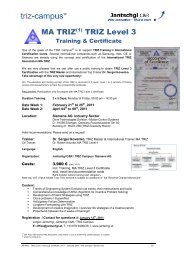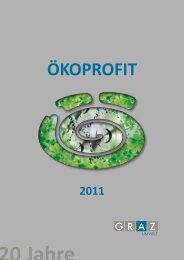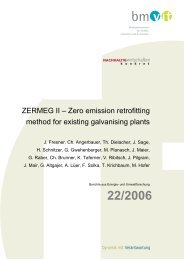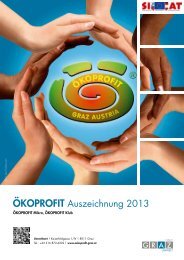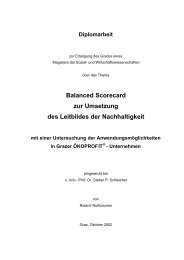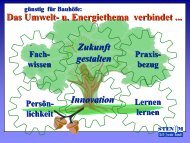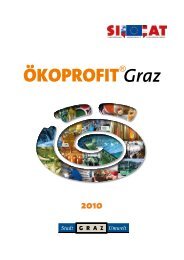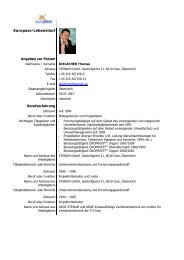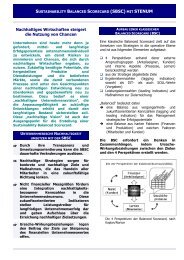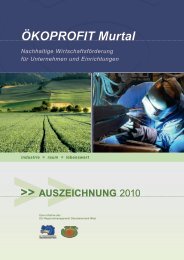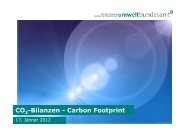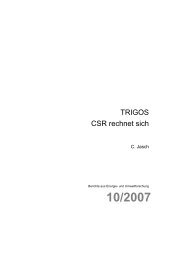Promoting Resource Efficiency in Small & Medium size ... - UNEP
Promoting Resource Efficiency in Small & Medium size ... - UNEP
Promoting Resource Efficiency in Small & Medium size ... - UNEP
Create successful ePaper yourself
Turn your PDF publications into a flip-book with our unique Google optimized e-Paper software.
4.3 HOW:<br />
Implement a water sav<strong>in</strong>g programme<br />
Quick W<strong>in</strong> Map Explanation Tools (<strong>in</strong> the electronic version of<br />
the toolkit)<br />
Step 1:<br />
Draw a Water Flowchart<br />
Step 2:<br />
Collect Data<br />
Identify all uses of water by creat<strong>in</strong>g a<br />
water flowchart<br />
Collect and measure consumption data<br />
us<strong>in</strong>g resources available and log it<br />
Advanced Reference (<strong>in</strong> electronic<br />
version)<br />
Water Flowchart • Water Flowchart<br />
(with examples and templates to<br />
fill <strong>in</strong>)<br />
• Flowcharter (Programme l<strong>in</strong>k)<br />
• Guide to Water Balance<br />
Collect Data • Data Entry Form<br />
(see advanced reference<br />
“ Water Flowchart”)<br />
Step 3:<br />
Benchmark Performance<br />
Step 4:<br />
Consider Options<br />
Step 5:<br />
Evaluate Option and Implement<br />
Program<br />
Benchmark your consumption with<br />
best practice to determ<strong>in</strong>e improvement<br />
potential<br />
Consider options towards improv<strong>in</strong>g the<br />
plant’s water efficiency from literature,<br />
other <strong>in</strong>dustries’ experiences and/<br />
or recommendations from RE, CP and<br />
SP service providers. Also undergo<br />
bra<strong>in</strong>storm<strong>in</strong>g sessions with your team.<br />
Evaluate option, compile and implement<br />
programme (l<strong>in</strong>k to PDCA)<br />
Benchmark Performance • Sectoral Benchmark<br />
• Unit Process Benchmark<br />
Consider Options • Option Evaluation Worksheet<br />
• Further detailed process and<br />
sector related options see Virtual<br />
Assessment<br />
L<strong>in</strong>k to DO-phase<br />
Table 10: Quick W<strong>in</strong> Map for reduc<strong>in</strong>g water consumption<br />
A water efficiency programme starts with a bird’s-eye view of water<br />
consumption. Draft a flowchart show<strong>in</strong>g the water flows as suggested<br />
at the top of Table 10. Then take measurements to fill the flowchart<br />
with data. Benchmark water efficiency on the basis of specific water<br />
consumption per production unit. With this data on hand, options for<br />
reduction will become obvious. Selected options will be organised <strong>in</strong><br />
the action plan, which is part of the PDCA-cycle.<br />
Step 1: Draw a Water Flowchart<br />
To identify potential water efficiency opportunities, it is first necessary<br />
to ga<strong>in</strong> a thorough understand<strong>in</strong>g of the site’s water uses through a<br />
water assessment. The first important task is to construct a water flow<br />
diagram, which identifies all water use from its source through the on-site<br />
processes, mach<strong>in</strong>es, build<strong>in</strong>gs and landscape irrigation to evaporation<br />
and wastewater discharge.<br />
For further <strong>in</strong>formation on how to draw a water flowchart, please click<br />
on the advanced reference “Water Flowchart” on the Quick W<strong>in</strong> Map <strong>in</strong><br />
the electronic resourcekit and follow the <strong>in</strong>structions.<br />
Step 2: Collect Data<br />
Once all types of sources, uses and discharges of water have been<br />
identified, it is necessary to quantify all s<strong>in</strong>gle mass flows.<br />
Compared to many other material flows, collect<strong>in</strong>g data of water<br />
consumption is relatively easy because the follow<strong>in</strong>g documents or<br />
tools are <strong>in</strong> most cases available:<br />
• Annual payment to provider or to disposal companies<br />
• Water meter, water counter<br />
• Rotameter<br />
• Design specifications by manufactures of equipment<br />
• Indicators 28<br />
• Ultrasonic flow meter<br />
• The bucket method<br />
• Measur<strong>in</strong>g wastewater e.g. by us<strong>in</strong>g the V-notch method<br />
To account for all uses <strong>in</strong> the water balance, the total <strong>in</strong>flow should equal<br />
the total outflow plus irrigation, evaporation and other water losses.<br />
In case water meters are not available to measure the consumption <strong>in</strong><br />
s<strong>in</strong>gle departments or at <strong>in</strong>dividual mach<strong>in</strong>es, use the bucket and a<br />
stopwatch to identify the water flow (Figure 25).<br />
Use any bucket where you know the<br />
capacity or measure the capacity of the<br />
bucket before further steps (e.g. 10 liters<br />
or 2.5 gal). Take the bucket and fill the<br />
bucket with the hose where you want to<br />
know the flow. Count the time <strong>in</strong> seconds<br />
(e.g. 20 seconds) Divide the capacity by<br />
the time <strong>in</strong> seconds. You will get the water<br />
flow from the hose <strong>in</strong> litres per second or<br />
gallons per second.<br />
An example: 10 litres / 20 seconds =<br />
0.5 litres per second..<br />
To get the water flow (from per second) to<br />
per m<strong>in</strong>ute: multiply by 60 (60 seconds<br />
per one m<strong>in</strong>ute), per hour: multiply by<br />
3,600 (3,600 seconds per one hour) per<br />
day: multiply by 86,400 (86,400 seconds<br />
per one day).<br />
Figure 25: Measur<strong>in</strong>g water volume with a bucket and a watch<br />
28) UNIDO Cleaner Production Toolkit, Textbook Material flow analysis, 2008.<br />
36



